Effects of the Acoustic-Visual Indoor Environment on Relieving Mental Stress Based on Facial Electromyography and Micro-Expression Recognition
Abstract
:1. Introduction
2. Materials and Methods
2.1. Subjects
2.2. Experimental Site
2.3. Experimental Contents
2.3.1. Collection of Facial EMG Signals and Micro-Expression
2.3.2. Methods of Stress Induction and Recovery
2.4. Experimental Procedures
2.5. Subjective Questionnaire
2.6. Data Analysis
3. Results
3.1. Facial Micro-Expression Recognition Results for Three Environments
3.2. Subjective Questionnaire Results for Three Environments
3.3. Results of Facial EMG under Three Environments
4. Discussion
4.1. Comparative Analysis of Facial Micro-Expression Recognition and Subjective Questionnaire Results
4.2. Comparing the Recovery Effects of Different Environments
4.3. Comparison with Results from Other Studies
4.4. Limitations and Future Research
5. Conclusions
- Changes in micro-expressions occur when stimulated by stress. Facial micro-expression recognition and facial EMG can be used as assessment methods for psychological stress.
- Natural visual, auditory, and audiovisual environments help relieve human mental stress.
- The analysis of the results of the emotional subjective questionnaire and MERCNN model in different visual-acoustic environments revealed a high degree of consistency between the two results.
- The results of the facial EMG showed that the recovery effect in the auditory and the audiovisual environments was better than that in the visual environment.
Author Contributions
Funding
Institutional Review Board Statement
Informed Consent Statement
Data Availability Statement
Conflicts of Interest
References
- Esslinger, G.E. Human Health and the Indoor Environment: An Analysis of Building Materials and Sustainable Architecture. Doctoral Dissertation, The University of Texas at Austin, Austin, TX, USA, 2020. [Google Scholar] [CrossRef]
- Cai, M.; Xiang, L.Y.; Ng, E. How does the visual environment influence pedestrian physiological stress? Evidence from high-density cities using ambulatory technology and spatial machine learning. Sust. Cities Soc. 2023, 96, 14. [Google Scholar] [CrossRef]
- Chandola, T.; Heraclides, A.; Kumari, M. Psychophysiological biomarkers of workplace stressors. Neurosci. Biobehav. Rev. 2010, 35, 51–57. [Google Scholar] [CrossRef] [PubMed]
- Olafsdottir, G.; Cloke, P.; Schulz, A.; Van Dyck, Z.; Eysteinsson, T.; Thorleifsdottir, B.; Vögele, C. Health Benefits of Walking in Nature: A Randomized Controlled Study Under Conditions of Real-Life Stress. Environ. Behav. 2020, 52, 248–274. [Google Scholar] [CrossRef]
- Ulrich, R.S.; Simons, R.F.; Losito, B.D.; Fiorito, E.; Miles, M.A.; Zelson, M. Stress recovery during exposure to natural and urban environments. J. Environ. Psychol. 1991, 11, 201–230. [Google Scholar] [CrossRef]
- Elsadek, M.; Liu, B. Effects of viewing flowering plants on employees’ wellbeing in an office-like environment. Indoor Built Environ. 2021, 30, 1429–1440. [Google Scholar] [CrossRef]
- Dannenmaier, M. Healing gardens. Landsc. Archit. 1995, 85, 56. [Google Scholar]
- Ulrich, R. Archive: Reports: The Effect of Healthcare Architecture and Art on Medical Outcomes. Reports on Arts Council England Architecture Week Event. 25 June 2003. Available online: https://www.mendeley.com/catalogue/da92a65d-2da3-3439-b28e-5b48cf9bef00/ (accessed on 25 August 2024).
- Evensen, K.H.; Raanaas, R.K.; Hagerhall, C.M.; Johansson, M.; Patil, G.G. Restorative Elements at the Computer Workstation. Environ. Behav. 2015, 47, 288–303. [Google Scholar] [CrossRef]
- Han, K.-T. Influence of Limitedly Visible Leafy Indoor Plants on the Psychology, Behavior, and Health of Students at a Junior High School in Taiwan. Environ. Behav. 2009, 41, 658–692. [Google Scholar] [CrossRef]
- Mehaffy, M. Biophilic Design: The Theory, Science, and Practice of Bringing Buildings to Life. Proc. Inst. Civ. Eng. Urban Des. Plan. 2012, 165, 193. [Google Scholar] [CrossRef]
- Lipovac, D.; Burnard, M.D. Effects of visual exposure to wood on human affective states, physiological arousal and cognitive performance: A systematic review of randomized trials. Indoor Built Environ. 2021, 30, 1021–1041. [Google Scholar] [CrossRef]
- van den Berg, M.; Maas, J.; Muller, R.; Braun, A.; Kaandorp, W.; van Lien, R.; van Poppel, M.N.M.; van Mechelen, W.; van den Berg, A.E. Autonomic Nervous System Responses to Viewing Green and Built Settings: Differentiating Between Sympathetic and Parasympathetic Activity. Int. J. Environ. Res. Public Health 2015, 12, 15860–15874. [Google Scholar] [CrossRef] [PubMed]
- Zhang, X.; Ba, M.; Kang, J.; Meng, Q. Effect of soundscape dimensions on acoustic comfort in urban open public spaces. Appl. Acoust. 2018, 133, 73–81. [Google Scholar] [CrossRef]
- Golmohammadi, R.; Aliabadi, M.; Nezami, T. An Experimental Study of Acoustic Comfort in Open Space Banks Based on Speech Intelligibility and Noise Annoyance Measures. Arch. Acoust. 2017, 42, 333–345. [Google Scholar] [CrossRef]
- Yang, W.; Kang, J. Acoustic comfort evaluation in urban open public spaces. Appl. Acoust. 2005, 66, 211–229. [Google Scholar] [CrossRef]
- Michels, N.; Hamers, P. Nature Sounds for Stress Recovery and Healthy Eating: A Lab Experiment Differentiating Water and Bird Sound. Environ. Behav. 2023, 55, 175–205. [Google Scholar] [CrossRef]
- Naef, A.C.; Jeitziner, M.-M.; Knobel, S.E.J.; Exl, M.T.; Müri, R.M.; Jakob, S.M.; Nef, T.; Gerber, S.M. Investigating the role of auditory and visual sensory inputs for inducing relaxation during virtual reality stimulation. Sci. Rep. 2022, 12, 17073. [Google Scholar] [CrossRef]
- Li, Z.Z.; Ba, M.H.; Kang, J. Physiological indicators and subjective restorativeness with audio-visual interactions in urban soundscapes. Sust. Cities Soc. 2021, 75, 103360. [Google Scholar] [CrossRef]
- Xu, Z.; Yang, M.; Yu, L. Identification, Evaluation, and Influencing Factors of Soundscapes in Public Open Spaces in High-Density Residential Areas. Applied Sciences 2024, 14, 6946. [Google Scholar] [CrossRef]
- Kroll, S.L.; Mayo, L.M.; Asratian, A.; Yngve, A.; Perini, I.; Heilig, M. Negative self-evaluation induced by acute stress indexed using facial EMG. Psychoneuroendocrinology 2021, 133, 105402. [Google Scholar] [CrossRef] [PubMed]
- Hong, X.C.; Cheng, S.; Liu, J.; Dang, E.; Wang, J.B.; Cheng, Y.N. The Physiological Restorative Role of Soundscape in Different Forest Structures. Forests 2022, 13, 1920. [Google Scholar] [CrossRef]
- Lazarus, R.S. Stress and Emotion: A New Synthesis; Springer Publishing Company: Berlin/Heidelberg, Germany, 2006. [Google Scholar]
- Goldman, A.I.; Sripada, C.S. Simulationist models of face-based emotion recognition. Cognition 2005, 94, 193–213. [Google Scholar] [CrossRef] [PubMed]
- Vuilleumier, P.; Pourtois, G. Distributed and interactive brain mechanisms during emotion face perception: Evidence from functional neuroimaging. Neuropsychologia 2007, 45, 174–194. [Google Scholar] [CrossRef] [PubMed]
- Scherer, K.R. Voice, Stress, and Emotion; Springer US: Boston, MA, USA, 1986; pp. 157–179. [Google Scholar] [CrossRef]
- Chen, Y.M.; Yang, Z.L.; Wang, J.P. Eyebrow emotional expression recognition using surface EMG signals. Neurocomputing 2015, 168, 871–879. [Google Scholar] [CrossRef]
- Cacioppo, J.T.; Petty, R.E.; Losch, M.E.; Kim, H.S. Electromyographic activity over facial muscle regions can differentiate the valence and intensity of affective reactions. J. Personal. Soc. Psychol. 1986, 50, 260–268. [Google Scholar] [CrossRef]
- Sloan, D.M.; Bradley, M.M.; Dimoulas, E.; Lang, P.J. Looking at facial expressions: Dysphoria and facial EMG. Biol. Psychol. 2002, 60, 79–90. [Google Scholar] [CrossRef] [PubMed]
- Kim, H.; Zhang, D.; Kim, L.; Im, C.H. Classification of Individual’s discrete emotions reflected in facial microexpressions using electroencephalogram and facial electromyogram. Expert Syst. Appl. 2022, 188, 116101. [Google Scholar] [CrossRef]
- Künecke, J.; Hildebrandt, A.; Recio, G.; Sommer, W.; Wilhelm, O. Facial EMG Responses to Emotional Expressions Are Related to Emotion Perception Ability. PLoS ONE 2014, 9, e84053. [Google Scholar] [CrossRef]
- Mohan, K.; Seal, A.; Krejcar, O.; Yazidi, A. Facial Expression Recognition Using Local Gravitational Force Descriptor-Based Deep Convolution Neural Networks. IEEE Trans. Instrum. Meas. 2021, 70, 1–12. [Google Scholar] [CrossRef]
- Golland, Y.; Hakim, A.; Aloni, T.; Schaefer, S.; Levit-Binnun, N. Affect dynamics of facial EMG during continuous emotional experiences. Biol. Psychol. 2018, 139, 47–58. [Google Scholar] [CrossRef] [PubMed]
- Okada, G.; Yonezawa, T.; Kurita, K.; Tsumura, N. [Paper] Monitoring Emotion by Remote Measurement of Physiological Signals Using an RGB Camera. ITE Trans. Media Technol. Appl. 2018, 6, 131–137. [Google Scholar] [CrossRef]
- Torre, F.D.L.; Chu, W.S.; Xiong, X.; Vicente, F.; Cohn, J. IntraFace. In Proceedings of the 2015 11th IEEE International Conference and Workshops on Automatic Face and Gesture Recognition (FG), Ljubljana, Slovenia, 4–8 May 2015. [Google Scholar] [CrossRef]
- Hu, S.T.; Sun, J.; Zhang, J.; Liu, G.D.; Zhao, S.P. Thermoacoustic environment comfort evaluation method based on facial micro-expression recognition. Build. Environ. 2022, 221, 109263. [Google Scholar] [CrossRef]
- Lan, L.; Lian, Z. Application of statistical power analysis—How to determine the right sample size in human health, comfort and productivity research. Build. Environ. 2010, 45, 1202–1213. [Google Scholar] [CrossRef]
- Seppänen, O.A.; Fisk, W. Some Quantitative Relations between Indoor Environmental Quality and Work Performance or Health. HVAC&R Res. 2006, 12, 957–973. [Google Scholar] [CrossRef]
- Zhu, H.; Wang, H.Q.; Liu, Z.Q.; Li, D.R.; Kou, G.X.; Li, C. Experimental study on the human thermal comfort based on the heart rate variability (HRV) analysis under different environments. Sci. Total Environ. 2018, 616, 1124–1133. [Google Scholar] [CrossRef] [PubMed]
- Dang, Y.; Liu, Z.; Yang, X.; Ge, L.; Miao, S. A fatigue assessment method based on attention mechanism and surface electromyography. Internet Things Cyber-Phys. Syst. 2023, 3, 112–120. [Google Scholar] [CrossRef]
- Tagawa, Y.; Maskeliūnas, R.; Damaševičius, R. Acoustic Anomaly Detection of Mechanical Failures in Noisy Real-Life Factory Environments. Electronics 2021, 10, 2329. [Google Scholar] [CrossRef]
- Miedema, H.M.; Oudshoorn, C.G. Annoyance from transportation noise: Relationships with exposure metrics DNL and DENL and their confidence intervals. Environ. Health Perspect. 2001, 109, 409–416. [Google Scholar] [CrossRef]
- Rossi, L.; Prato, A.; Lesina, L.; Schiavi, A. Effects of low-frequency noise on human cognitive performances in laboratory. Build. Acoust. 2018, 25, 17–33. [Google Scholar] [CrossRef]
- Minichilli, F.; Gorini, F.; Ascari, E.; Bianchi, F.; Coi, A.; Fredianelli, L.; Licitra, G.; Manzoli, F.; Mezzasalma, L.; Cori, L. Annoyance Judgment and Measurements of Environmental Noise: A Focus on Italian Secondary Schools. Int. J. Environ. Res. Public Health 2018, 15, 208. [Google Scholar] [CrossRef]
- Reuter, C.; Oehler, M. Psychoacoustics of chalkboard squeaking. J. Acoust. Soc. Am. 2011, 130, 2545. [Google Scholar] [CrossRef]
- Westman, J.C.; Walters, J.R. Noise and stress: A comprehensive approach. Environ. Health Perspect. 1981, 41, 291–309. [Google Scholar] [CrossRef] [PubMed]
- Kreutz, G.; Quiroga Murcia, C.; Bongard, S. Psychoneuroendocrine Research on Music and Health: An Overview; Oxford University Press: Oxford, UK, 2012; pp. 458–476. [Google Scholar] [CrossRef]
- Nicol, J.F.; Humphreys, M.A. Adaptive thermal comfort and sustainable thermal standards for buildings. Energy Build. 2002, 34, 563–572. [Google Scholar] [CrossRef]
- Shuttleworth, S. The use of photographs as an environmental presentation medium in landscape studies. Environ. Manag. J. Environ. Manag. 1980, 11, 61–76. [Google Scholar]
- Diener, E.; Wirtz, D.; Biswas-Diener, R.; Tov, W.; Kim-Prieto, C.; Choi, D.-W.; Oishi, S. New Measures of Well-Being; Springer: Dordrecht, The Netherlands, 2009; pp. 247–266. [Google Scholar] [CrossRef]
- Diener, E.; Wirtz, D.; Tov, W.; Kim-Prieto, C.; Choi, D.-W.; Oishi, S.; Biswas-Diener, R. New Well-being Measures: Short Scales to Assess Flourishing and Positive and Negative Feelings. Soc. Indic. Res. 2010, 97, 143–156. [Google Scholar] [CrossRef]
- Vinutha, H.P.; Poornima, B.; Sagar, B.M. Detection of Outliers Using Interquartile Range Technique from Intrusion Dataset; Springer: Singapore, 2018; pp. 511–518. [Google Scholar] [CrossRef]
- Cassina, L.; Fredianelli, L.; Menichini, I.; Chiari, C.; Licitra, G. Audio-Visual Preferences and Tranquillity Ratings in Urban Areas. Environments 2017, 5, 1. [Google Scholar] [CrossRef]
- Preis, A.; Hafke-Dyx, H.; Szychowska, M.; Kocinski, J.; Felcyn, J. Audio-visual interaction of environmental noise. Noise Control. Eng. J. 2016, 64, 34–43. [Google Scholar] [CrossRef]
- Yang, X.; Kang, J. Effect of Audio–Visual Factors in the Evaluation of Crowd Noise. Appl. Sci. 2023, 13, 3652. [Google Scholar] [CrossRef]
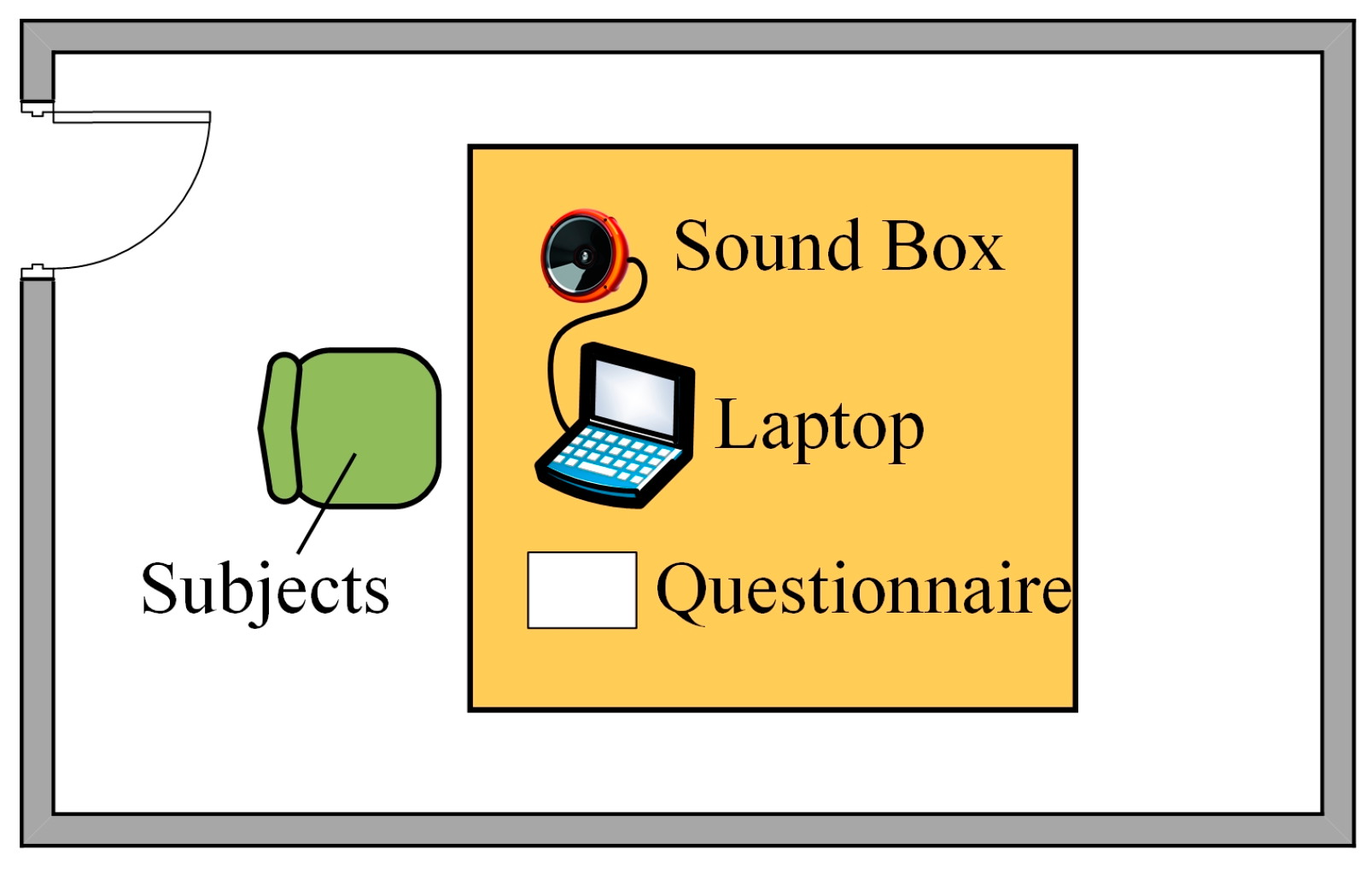
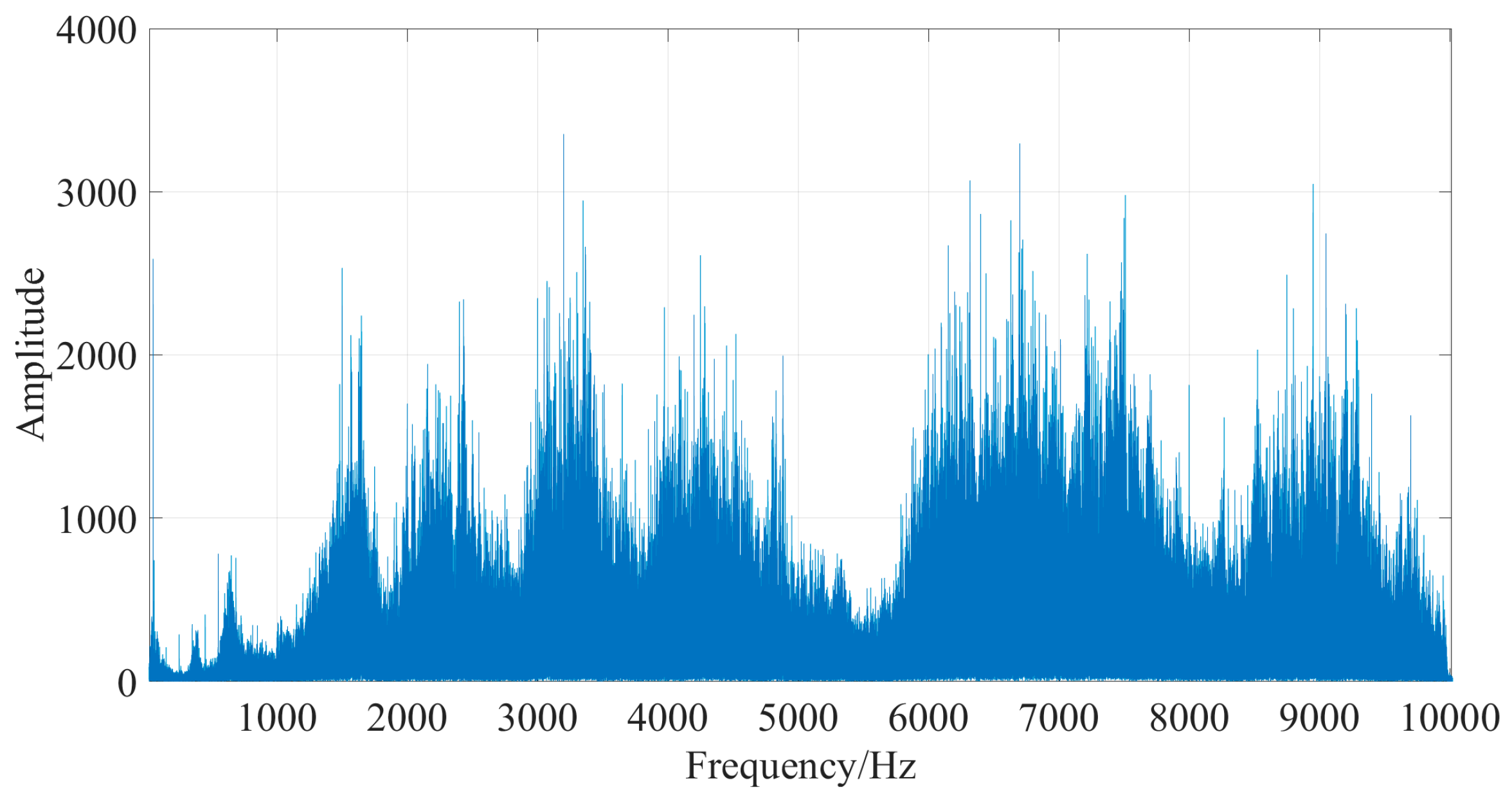


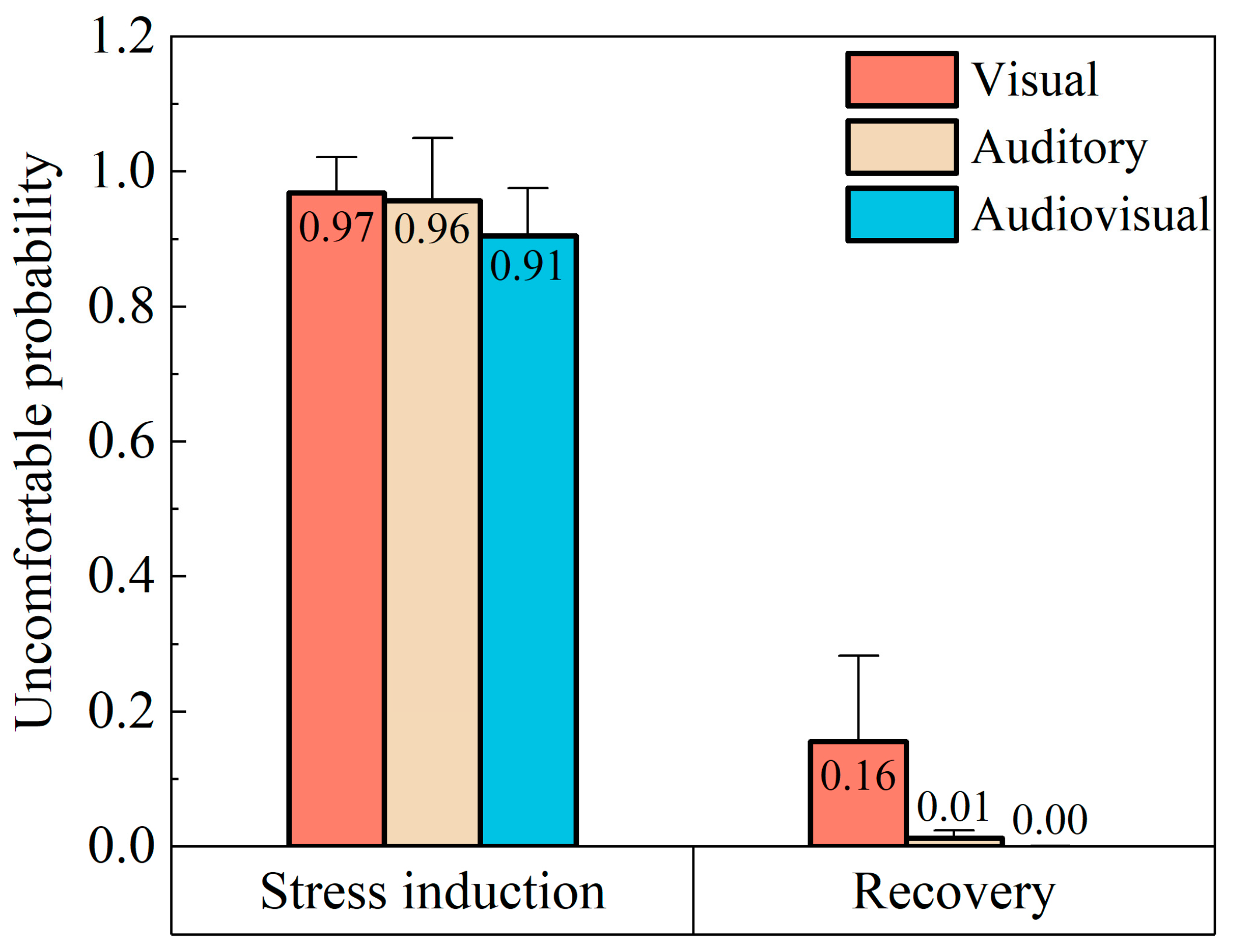

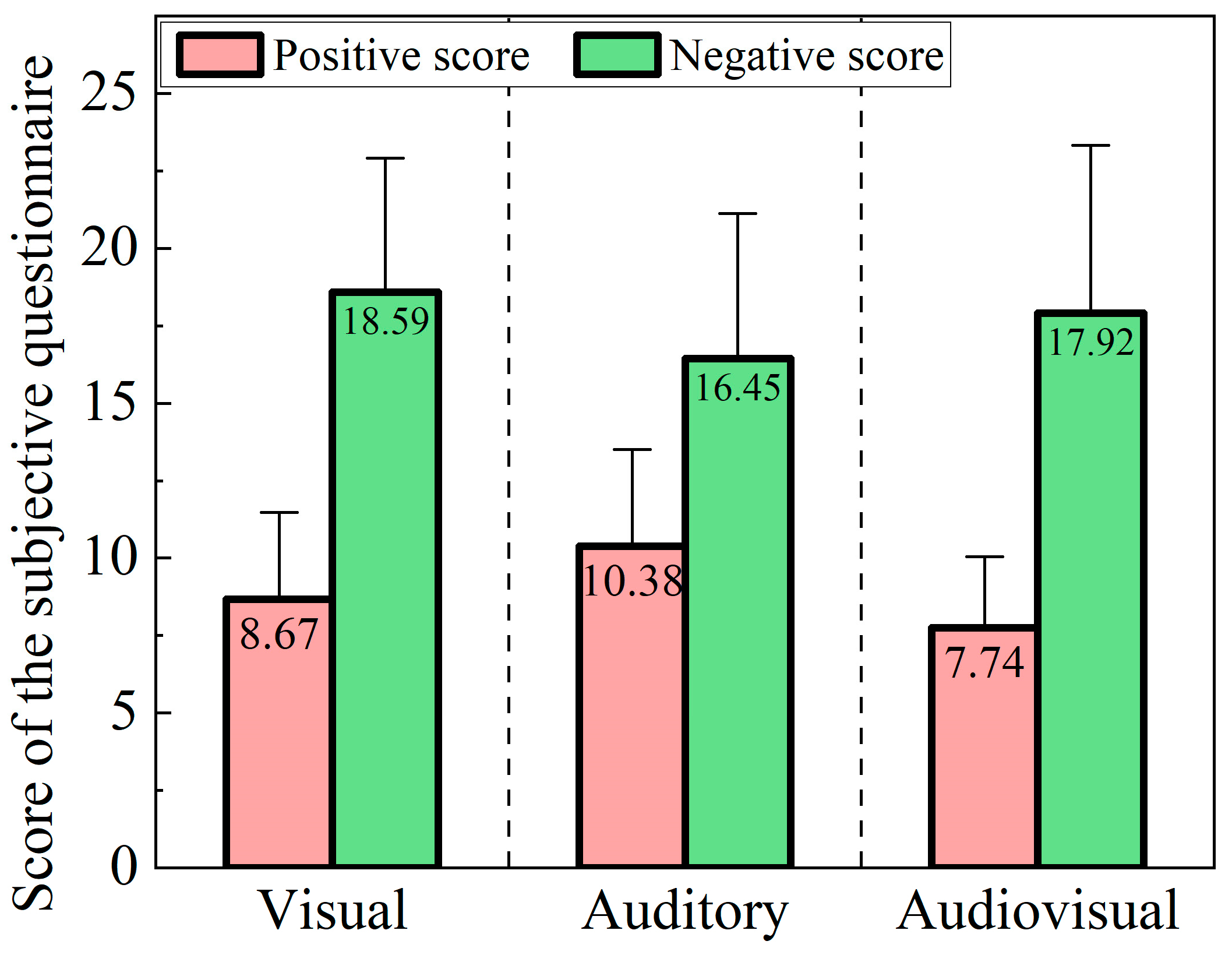



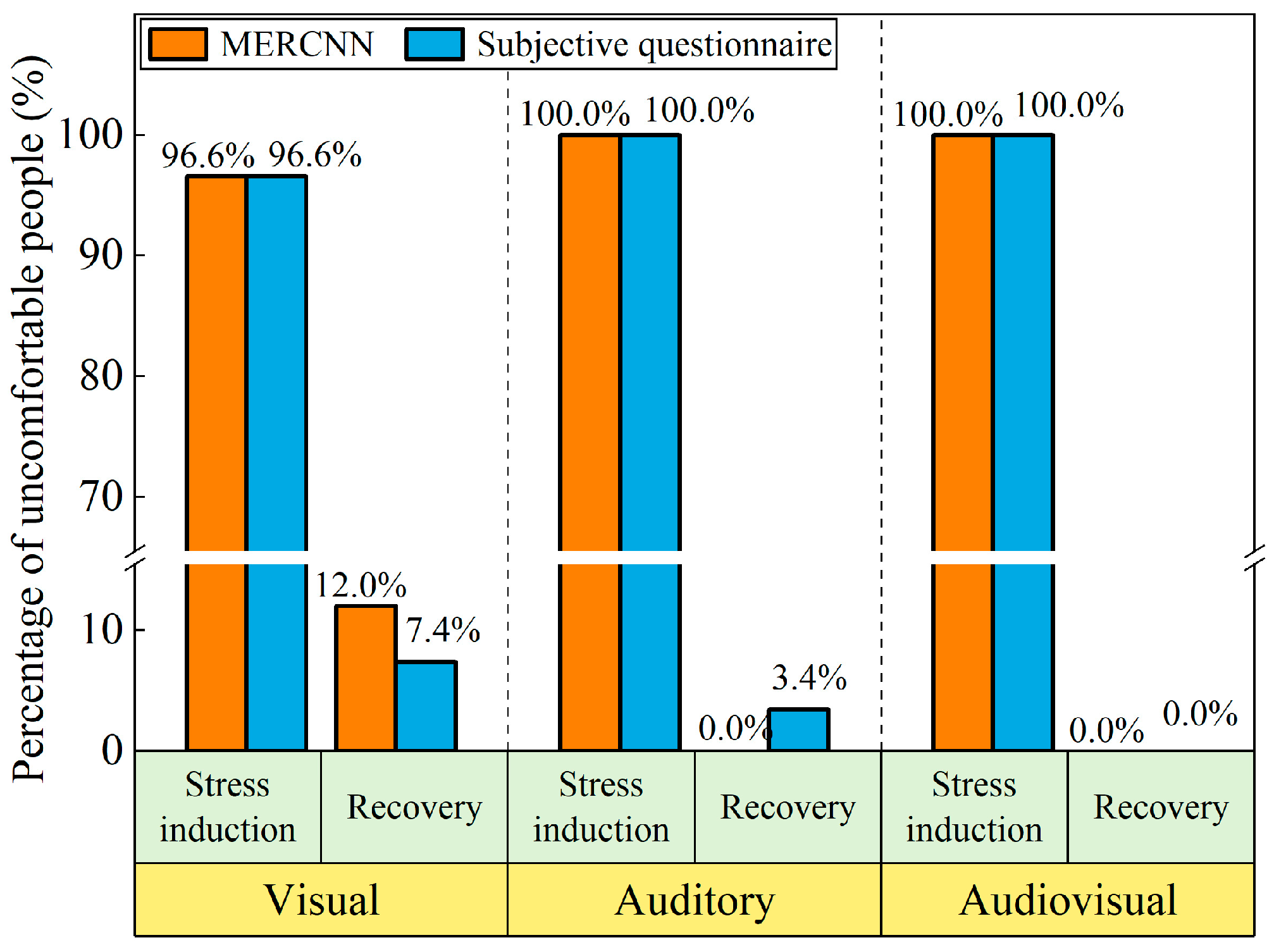
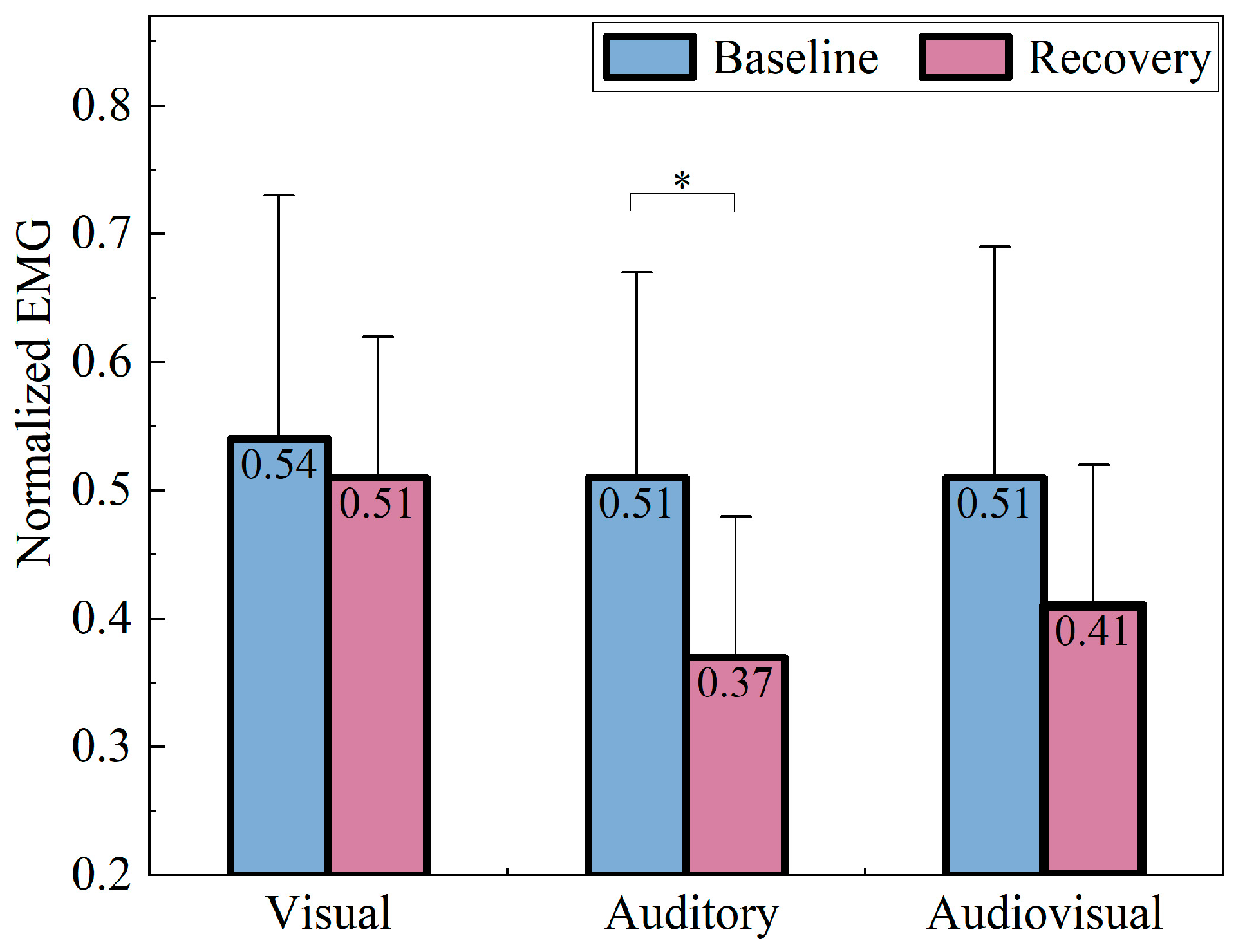
| Gender | Number of Subjects | Age (Years) | Height (cm) | Weight (kg) |
|---|---|---|---|---|
| Male | 14 | 23.23 ± 0.83 | 177.23 ± 3.59 | 73.13 ± 12.44 |
| Female | 14 | 22.38 ± 0.60 | 163.38 ± 5.37 | 58.25 ± 8.36 |
| Name | Parameters | Equipment Diagram | Type, Manufacturer, Country | Measurement Range |
|---|---|---|---|---|
| EMG acquisition equipment | EMG signals |  | MyoWare Muscle Sensor, Advancer Technologies, USA | 0~1500 Hz |
| Camera | Micro-expression |  | Mosengsm Q15, Mosengsm, China | P480 |
| Emotions | Rating | ||||
|---|---|---|---|---|---|
| 1 | 2 | 3 | 4 | 5 | |
| Positive | ◯ | ◯ | ◯ | ◯ | ◯ |
| Good | ◯ | ◯ | ◯ | ◯ | ◯ |
| Pleasant | ◯ | ◯ | ◯ | ◯ | ◯ |
| Happy | ◯ | ◯ | ◯ | ◯ | ◯ |
| Joyful | ◯ | ◯ | ◯ | ◯ | ◯ |
| Contented | ◯ | ◯ | ◯ | ◯ | ◯ |
| Negative | ◯ | ◯ | ◯ | ◯ | ◯ |
| Bad | ◯ | ◯ | ◯ | ◯ | ◯ |
| Unpleasant | ◯ | ◯ | ◯ | ◯ | ◯ |
| Sad | ◯ | ◯ | ◯ | ◯ | ◯ |
| Afraid | ◯ | ◯ | ◯ | ◯ | ◯ |
| Angry | ◯ | ◯ | ◯ | ◯ | ◯ |
| Experimental Stage | Experimental Conditions | ||
|---|---|---|---|
| Visual | Auditory | Audiovisual | |
| Stress induction | 96.55% | 100% | 100% |
| Recovery | 7.4% | 3.44% | 0% |
Disclaimer/Publisher’s Note: The statements, opinions and data contained in all publications are solely those of the individual author(s) and contributor(s) and not of MDPI and/or the editor(s). MDPI and/or the editor(s) disclaim responsibility for any injury to people or property resulting from any ideas, methods, instructions or products referred to in the content. |
© 2024 by the authors. Licensee MDPI, Basel, Switzerland. This article is an open access article distributed under the terms and conditions of the Creative Commons Attribution (CC BY) license (https://creativecommons.org/licenses/by/4.0/).
Share and Cite
Liu, G.; Hu, P.; Zhong, H.; Yang, Y.; Sun, J.; Ji, Y.; Zou, J.; Zhu, H.; Hu, S. Effects of the Acoustic-Visual Indoor Environment on Relieving Mental Stress Based on Facial Electromyography and Micro-Expression Recognition. Buildings 2024, 14, 3122. https://doi.org/10.3390/buildings14103122
Liu G, Hu P, Zhong H, Yang Y, Sun J, Ji Y, Zou J, Zhu H, Hu S. Effects of the Acoustic-Visual Indoor Environment on Relieving Mental Stress Based on Facial Electromyography and Micro-Expression Recognition. Buildings. 2024; 14(10):3122. https://doi.org/10.3390/buildings14103122
Chicago/Turabian StyleLiu, Guodan, Pengcheng Hu, Huiyang Zhong, Yang Yang, Jie Sun, Yihang Ji, Jixin Zou, Hui Zhu, and Songtao Hu. 2024. "Effects of the Acoustic-Visual Indoor Environment on Relieving Mental Stress Based on Facial Electromyography and Micro-Expression Recognition" Buildings 14, no. 10: 3122. https://doi.org/10.3390/buildings14103122






